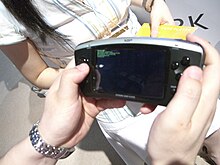 | |
| Manufacturer | GamePark |
|---|---|
| Type | Handheld game console |
| Generation | Seventh generation era |
| Lifespan | Never Released |
| Introductory price | $300 |
| Media | Secure Digital card |
| System on a chip | MagicEyes VRENDER-3D |
| CPU | Dual CPU:
200MHz Host ARM920T 200MHz ARM940T |
| Memory | 64MB-128MB (DDR SDRAM) |
| Storage | 64MB NAND Flash |
The XGP (Extreme Game Player) was a concept portable video game system created by the Korean company GamePark as the follow-up to its GP32 handheld. Initially announced in 2005,[1] the XGP was finally announced in March 2006 along with the release of the similar XGP Mini[2] and the XGP Kids. The company went bankrupt before releasing any of the models.[3]
The XGP was scheduled to be released in three models: the XGP, the XGPmini and the XGP Kids. GamePark said that it did not wish to compete with Sony and Nintendo with the device. The XGP Kids was aimed towards children and therefore had a significantly lower price point. It was designed to run simpler games tailored to an audience besides 'hardcore gamers'. While the GP32 was only available in select markets—Korea and parts of Europe and Asia—or had to be imported, the XGP was expected to be marketed worldwide
Since Gamepark declared bankruptcy in March 2007,[3][4] the XGP went unreleased. This left GP2X—created by splinter company Gamepark Holdings—as the only successor to the GP32 to make it to market.[3]
- ^ Dybwad, B. (August 17, 2005). "Gamepark XGP handheld game console". Engadget. Retrieved 19 May 2022.
- ^ Blass, E (March 3, 2006). "Gamepark announces redesigned XGP and surprise XGP Mini". Engadget. Retrieved 19 May 2022.
- ^ a b c Melanson, D. (March 19, 2007). "GamePark goes under, GamePark Holdings still kickin'". Engadget. Retrieved 19 May 2022.
- ^ "Gamepark files for bankruptcy". 2007-03-13. Archived from the original on 2022-06-10. Retrieved 2007-09-09.